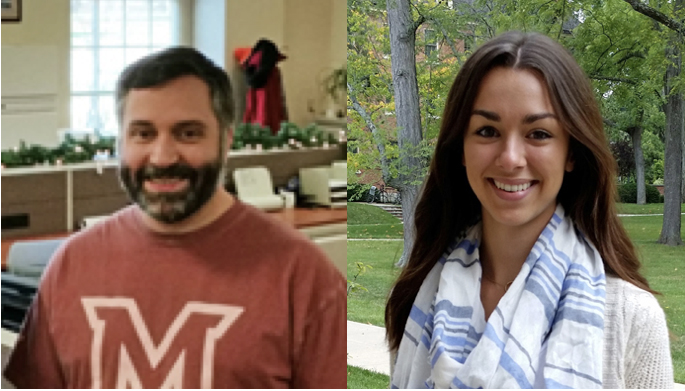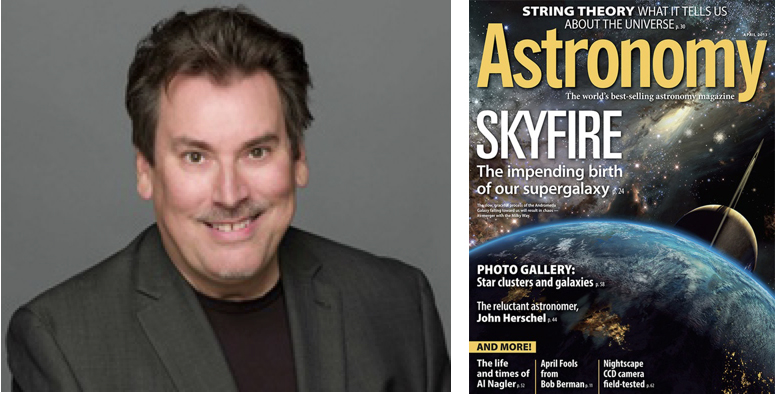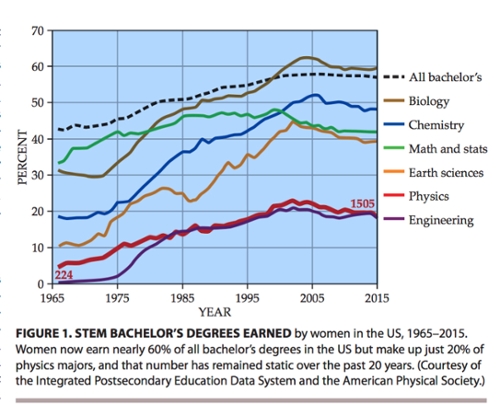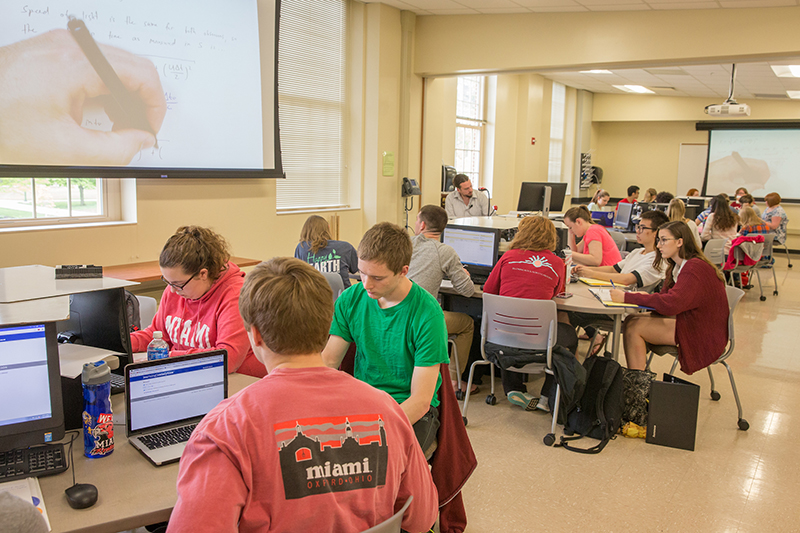
Five ways physics students and faculty help create community
By Susan Meikle, university news
Through student-led organizations and mentoring, faculty research on gender bias and stereotypes in physics, and other projects, Miami's physics department works to support undergraduate success.
Here are five ways students and faculty are helping to build community in physics.

Miami's Society for Physics Students hosts a picnic twice a year for the department of physics (photo courtesy of Jay Murdock).
Physics students build community - SPS awarded Outstanding Chapter
Miami Chapter of the Society for Physics Students (SPS) was awarded the "Outstanding Chapter" designation by the national office. Recognized for their commitment to outreach and fostering a strong community through social activities, this is the highest level of distinction awarded. The Miami chapter was one of 72 chapters out of 813 honored in 2017.
The SPS officer
Read Carroll’s story about the Miami chapter of SPS “We Built Our Community Without a Single Movie Night.”
Building more community: Physics mentor program for students, by students

Physics graduate students Patrick Carroll (left), a Marine Corps veteran, and Sara Zanfardino created the Physics Student Mentor Program.
Now in its second year, the physics mentor program was created by physics graduate students Patrick Carroll and Sara Zanfardino. Student volunteers (seniors and master’s students) aid new students in their transition into the physics department by acting as a bridge between students and faculty, providing guidance on class scheduling, aiding in the involvement of undergraduate research, and diminishing the social gap between upper and
Carroll — a Marine Corps veteran with a background in music and journalism — is completing the combined BS/MS degree in physics and conducts research with Jennifer Blue. Zanfardino (Miami ’15, BS in biochemistry) and conducts research with Karthik Vishwanath, the James and Carole Garland Professor of Physics.
Learn more about Carroll,
Returning to his community: David Eicher to give Benson Memorial Lecture April 12

Astronomy enthusiast David Eicher grew up in Oxford and is editor-in-chief of Astronomy magazine.
Eicher will present “The New Cosmos: Astronomy’s Ongoing Revolution” at 7 p.m. Thursday, April 12, in 319 Kreger. For a general audience.
Eicher, editor, writer, and popularizer of astronomy and space, is considered one of the most widely recognized astronomy enthusiasts in the world. He has been with Astronomy magazine for 34 years, beginning as an assistant editor. He has been the magazine’s chief editor since 2002.
He has spoken widely to amateur astronomy groups and written eight books on astronomy. Among the most used by amateur astronomers are The New Cosmos: Answering Astronomy’s Big Questions; Comets: Visitors from Deep Space; The Universe from Your Backyard; and Deep-Sky Observing with Small Telescopes.
His love of astronomy began when he was a young teenager and attended a “star party” in Oxford where he first looked at Saturn through a telescope. He joined the local astronomy club and in 1977, as a 15-year-old student at Talawanda High
 Physics education researcher Jennifer Blue: How to support inclusion and “Gender Matters”
Physics education researcher Jennifer Blue: How to support inclusion and “Gender Matters”
In her recently published article “Gender Matters,” Jennifer Blue, associate professor of physics, highlights studies that show systemic bias against women in physics, examine implicit bias, and consider stereotypes about women and about physics. Demographic data consistently show that the physics field is 75 percent male and seven percent white. There's a growing consensus that this is a problem, Blue says.
“Evidence shows that patterns of inequity in physics drive talented women out of the field,”
“Simply put, research always involves people. To ensure an intellectually vibrant and diverse future for our discipline, we must find ways to work together using practices that support inclusion rather exclusion in our classrooms and labs,”
Their article is in the March issue of Physics Today.
Percent women in these majors at Miami in 2016-2017:
Physics majors: 16 percent; biological physics majors: 23 percent; engineering physics majors: 12.5 percent.
NSF-awarded research: Psychology and physics collaborate to engineer student success

Students in the Physics 1 course
While a majority of introductory engineering students at Miami pass their required first-year physics classes, about 20 percent earn a “D,” “F” or “W,” according to Blue.
This pattern is amplified nationwide: according to a 2013 report by the National Center for Education Statistics, nearly half of students who begin pursuing a bachelor’s degree in STEM fields drop out of that pipeline before earning a degree. Among other factors that contribute to this is performing poorly in STEM classes relative to non-STEM classes.
Blue is part of a team with Amy Summerville (principal investigator), associate professor of psychology, and Brian Kirkmeyer, senior assistant dean for student success in the College of Engineering and Computing, awarded a $368,000 grant from the National Science Foundation (2015-2019) to develop an intervention to improve engineering students’ success in physics courses.
Their project “A Preliminary Investigation of a Social Cognitive Intervention in Early Courses,” draws on Summerville’s area of expertise in counterfactual thinking, or thinking about how things might have been, as opposed to how things actually are.
Helping engineering students who experience an early setback in a physics class – such as receiving a “D” or “F” on the first exam – think about what they might have done differently before that exam could improve their future performance, according to Summerville.
One idea is a worksheet that physics instructors would give to students when they hand back the first exam. The worksheet would ask students a series of questions about how they prepared for the exam and encourage them to reflect on their performance. It would ask students to generate ideas about what they could do differently to prepare for the next exam, such as completing their homework, coming to class, asking for help or going to office hours.
If the social cognitive intervention approach proves effective, it would have a significant advantage over many other interventions that have been tried in the past, according to the research team.
